
Optical illusion
Encyclopedia
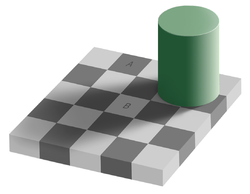
Visual perception
Visual perception is the ability to interpret information and surroundings from the effects of visible light reaching the eye. The resulting perception is also known as eyesight, sight, or vision...
images that differ from objective reality. The information gathered by the eye is processed in the brain to give a perception
Perception
Perception is the process of attaining awareness or understanding of the environment by organizing and interpreting sensory information. All perception involves signals in the nervous system, which in turn result from physical stimulation of the sense organs...
that does not tally with a physical measurement of the stimulus source. There are three main types: literal optical illusions that create images that are different from the objects that make them, physiological ones that are the effects on the eyes and brain of excessive stimulation of a specific type (brightness, colour, size, position, tilt, movement), and cognitive illusions, the result of unconscious inferences.
Physiological illusions

Afterimage
An afterimage or ghost image or image burn-in is an optical illusion that refers to an image continuing to appear in one's vision after the exposure to the original image has ceased...
s following bright lights, or adapting stimuli of excessively longer alternating patterns (contingent perceptual aftereffect), are presumed to be the effects on the eyes or brain of excessive stimulation or interaction with contextual or competing stimuli of a specific type—brightness, colour, position, tile, size, movement, etc. The theory is that a stimulus follows its individual dedicated neural path in the early stages of visual processing, and that intense or repetitive activity in that or interaction with active adjoining channels cause a physiological imbalance that alters perception.
The Hermann grid illusion
Grid illusion
A grid illusion is any kind of grid that deceives a person's vision. The two most common types of grid illusions are Hermann grid illusion and the Scintillating grid illusion.-Hermann grid illusion:...
and Mach bands
Mach bands
Mach bands is an optical illusion named after the physicist Ernst Mach. The illusion consists of light or dark stripes that are perceived next to the boundary between two regions of an image that have different lightness gradients .-Explanation:The Mach bands effect is due to the spatial...
are two illusion
Illusion
An illusion is a distortion of the senses, revealing how the brain normally organizes and interprets sensory stimulation. While illusions distort reality, they are generally shared by most people....
s that are best explained using a biological approach. Lateral inhibition
Lateral inhibition
In neurobiology, lateral inhibition is the capacity of an excited neuron to reduce the activity of its neighbors. Lateral inhibition sharpens the spatial profile of excitation in response to a localized stimulus.-Sensory inhibition:...
, where in the receptive field
Receptive field
The receptive field of a sensory neuron is a region of space in which the presence of a stimulus will alter the firing of that neuron. Receptive fields have been identified for neurons of the auditory system, the somatosensory system, and the visual system....
of the retina light and dark receptors compete with one another to become active, has been used to explain why we see bands of increased brightness at the edge of a colour difference when viewing Mach bands. Once a receptor is active it inhibits adjacent receptors. This inhibition creates contrast, highlighting edges. In the Hermann grid illusion the gray spots appear at the intersection because of the inhibitory response which occurs as a result of the increased dark surround. Lateral inhibition
Lateral inhibition
In neurobiology, lateral inhibition is the capacity of an excited neuron to reduce the activity of its neighbors. Lateral inhibition sharpens the spatial profile of excitation in response to a localized stimulus.-Sensory inhibition:...
has also been used to explain the Hermann grid illusion
Grid illusion
A grid illusion is any kind of grid that deceives a person's vision. The two most common types of grid illusions are Hermann grid illusion and the Scintillating grid illusion.-Hermann grid illusion:...
, but this has been disproved. More recent "empirical" approaches
Empirical theories of perception
An empirical theory of perception is a kind of explanation for how percepts arise. These theories hold that sensory systems incorporate information about the statistical properties of the natural world into their design and relate incoming stimuli to this information, rather than analyzing sensory...
to optical illusions have had some success in explaining optical phenomena with which theories based on lateral inhibition have struggled (e.g. Howe et al. 2005).
Cognitive illusions
Cognitive illusions are assumed to arise by interaction with assumptions about the world, leading to "unconscious inferences", an idea first suggested in the 19th century by Hermann HelmholtzHermann von Helmholtz
Hermann Ludwig Ferdinand von Helmholtz was a German physician and physicist who made significant contributions to several widely varied areas of modern science...
. Cognitive illusions are commonly divided into ambiguous illusions
Ambiguous image
Ambiguous images are optical illusion images which are crafted to exploit graphical similarities and other properties of visual system interpretation between two or more distinct image forms...
, distorting illusions, paradox illusions, or fiction illusions.
- Ambiguous illusions are pictures or objects that elicit a perceptual 'switch' between the alternative interpretations. The Necker cubeNecker cubeThe Necker Cube is an optical illusion first published as a rhomboid in 1832 by Swiss crystallographer Louis Albert Necker.-Ambiguity:The Necker Cube is an ambiguous line drawing....
is a well known example; another instance is the Rubin vaseRubin vaseRubin's vase is a famous set of ambiguous or bi-stable two-dimensional forms developed around 1915 by the Danish psychologist Edgar Rubin...
. - Distorting or geometrical-optical illusionsGeometrical-optical illusionsGeometrical-optical illusions are visual illusions, also optical illusions, in which the geometrical properties of what is seen differ from those of the corresponding objects in the visual field.-Geometrical properties:...
are characterized by distortions of size, length, position or curvature. A striking example is the Café wall illusionCafé wall illusionThe café wall illusion is a geometrical-optical illusion in which the parallel straight dividing lines between staggered rows with alternating black and white "bricks" appear to be sloped....
. Other examples is the famous Müller-Lyer illusion and Ponzo illusionPonzo illusionThe Ponzo illusion is a geometrical-optical illusion that was first demonstrated by the Italian psychologist Mario Ponzo in 1913. He suggested that the human mind judges an object's size based on its background. He showed this by drawing two identical lines across a pair of converging lines,...
. - Paradox illusions are generated by objects that are paradoxical or impossible, such as the Penrose trianglePenrose triangleThe Penrose triangle, also known as the Penrose tribar, is an impossible object. It was first created by the Swedish artist Oscar Reutersvärd in 1934. The mathematician Roger Penrose independently devised and popularised it in the 1950s, describing it as "impossibility in its purest form". It is...
or impossible staircases seen, for example, in M. C. EscherM. C. EscherMaurits Cornelis Escher , usually referred to as M. C. Escher , was a Dutch graphic artist. He is known for his often mathematically inspired woodcuts, lithographs, and mezzotints...
's Ascending and DescendingAscending and DescendingAscending and Descending is a lithograph print by the Dutch artist M. C. Escher which was first printed in March 1960.The original print measures 14" x 11 1/4”. The lithograph depicts a large building roofed by a never-ending staircase. Two lines of identically dressed men appear on the staircase,...
and WaterfallWaterfall (M. C. Escher)Waterfall is a lithography print by the Dutch artist M. C. Escher which was first printed in October, 1961. It shows an apparent paradox where water from the base of a waterfall appears to run downhill before reaching the top of the waterfall....
. The triangle is an illusion dependent on a cognitive misunderstanding that adjacent edges must join. - Fictions are when a figure is perceived even though it is not in the stimulus.
Perceptual organization
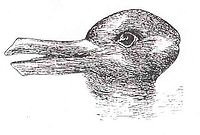
Gestalt psychology
Gestalt psychology or gestaltism is a theory of mind and brain of the Berlin School; the operational principle of gestalt psychology is that the brain is holistic, parallel, and analog, with self-organizing tendencies...
believe one way this is done is by perceiving individual sensory stimuli as a meaningful whole. Gestalt organization can be used to explain many illusions including the Duck-Rabbit illusion where the image as a whole switches back and forth from being a duck then being a rabbit and why in the figure-ground illusion the figure and ground are reversible.

Illusory Contours
Illusory contours or subjective contours are a form of visual illusion where contours are perceived without a luminance or color change across the contour. Friedrich Schumann discovered illusory contours.-Examples:...
in the Kanizsa Triangle. A floating white triangle, which does not exist, is seen. The brain has a need to see familiar simple objects and has a tendency to create a "whole" image from individual elements. Gestalt means "form" or "shape" in German. However, another explanation of the Kanizsa Triangle is based in evolutionary psychology
Evolutionary psychology
Evolutionary psychology is an approach in the social and natural sciences that examines psychological traits such as memory, perception, and language from a modern evolutionary perspective. It seeks to identify which human psychological traits are evolved adaptations, that is, the functional...
and the fact that in order to survive it was important to see form and edges. The use of perceptual organization to create meaning out of stimuli is the principle behind other well-known illusions including impossible objects. Our brain makes sense of shapes and symbols putting them together like a jigsaw puzzle, formulating that which isn't there to that which is believable.
Depth and motion perception
Illusions can be based on an individual's ability to see in three dimensions even though the image hitting the retina is only two dimensional. The Ponzo illusionPonzo illusion
The Ponzo illusion is a geometrical-optical illusion that was first demonstrated by the Italian psychologist Mario Ponzo in 1913. He suggested that the human mind judges an object's size based on its background. He showed this by drawing two identical lines across a pair of converging lines,...
is an example of an illusion which uses monocular cues of depth perception to fool the eye.
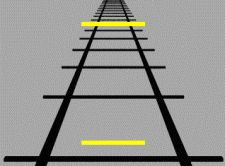
Parallel (geometry)
Parallelism is a term in geometry and in everyday life that refers to a property in Euclidean space of two or more lines or planes, or a combination of these. The assumed existence and properties of parallel lines are the basis of Euclid's parallel postulate. Two lines in a plane that do not...
tell the brain that the image higher in the visual field
Visual field
The term visual field is sometimes used as a synonym to field of view, though they do not designate the same thing. The visual field is the "spatial array of visual sensations available to observation in introspectionist psychological experiments", while 'field of view' "refers to the physical...
is farther away therefore the brain perceives the image to be larger, although the two images hitting the retina are the same size. The Optical illusion seen in a diorama
Diorama
The word diorama can either refer to a nineteenth century mobile theatre device, or, in modern usage, a three-dimensional full-size or miniature model, sometimes enclosed in a glass showcase for a museum...
/false perspective also exploits assumptions based on monocular cues of depth perception
Depth perception
Depth perception is the visual ability to perceive the world in three dimensions and the distance of an object. Depth sensation is the ability to move accurately, or to respond consistently, based on the distances of objects in an environment....
. The M. C. Escher
M. C. Escher
Maurits Cornelis Escher , usually referred to as M. C. Escher , was a Dutch graphic artist. He is known for his often mathematically inspired woodcuts, lithographs, and mezzotints...
painting Waterfall
Waterfall (M. C. Escher)
Waterfall is a lithography print by the Dutch artist M. C. Escher which was first printed in October, 1961. It shows an apparent paradox where water from the base of a waterfall appears to run downhill before reaching the top of the waterfall....
exploits rules of depth and proximity and our understanding of the physical world to create an illusion.
Like depth perception
Depth perception
Depth perception is the visual ability to perceive the world in three dimensions and the distance of an object. Depth sensation is the ability to move accurately, or to respond consistently, based on the distances of objects in an environment....
, motion perception
Motion perception
Motion perception is the process of inferring the speed and direction of elements in a scene based on visual, vestibular and proprioceptive inputs...
is responsible for a number of sensory illusions. Film animation
Animation
Animation is the rapid display of a sequence of images of 2-D or 3-D artwork or model positions in order to create an illusion of movement. The effect is an optical illusion of motion due to the phenomenon of persistence of vision, and can be created and demonstrated in several ways...
is based on the illusion that the brain perceives a series of slightly varied images produced in rapid succession as a moving picture. Likewise, when we are moving, as we would be while riding in a vehicle, stable surrounding objects may appear to move. We may also perceive a large object, like an airplane, to move more slowly than smaller objects, like a car, although the larger object is actually moving faster. The Phi phenomenon
Phi phenomenon
The phi phenomenon is an optical illusion defined by Max Wertheimer in the Gestalt psychology in 1912, in which the persistence of vision formed a part of the base of the theory of the cinema, applied by Hugo Münsterberg in 1916....
is yet another example of how the brain perceives motion, which is most often created by blinking lights in close succession.
Colour and brightness constancies
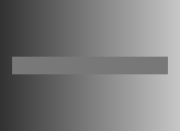
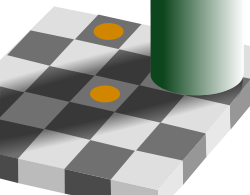
Color constancy
Color constancy is an example of subjective constancy and a feature of the human color perception system which ensures that the perceived color of objects remains relatively constant under varying illumination conditions. A green apple for instance looks green to us at midday, when the main...
and brightness constancy are responsible for the fact that a familiar object will appear the same colour regardless of the amount of or colour of light reflecting from it. An illusion of colour or contrast difference can be created when the luminosity or colour of the area surrounding an unfamiliar object is changed. The contrast of the object will appear darker against a black field that reflects less light compared to a white field even though the object itself did not change in colour. Similarly, the eye will compensate for colour contrast depending on the colour cast of the surrounding area.
Object consistencies
Just as it perceives colour and brightness constancies, the brain has the ability to understand familiar objects as having a consistent shape or size. For example a door is perceived as rectangle regardless of how the image may change on the retina as the door is opened and closed. Unfamiliar objects, however, do not always follow the rules of shape constancy and may change when the perspective is changed. The Shepard illusion of the changing table is an example of an illusion based on distortions in shape constancy.Future perception
Researcher Mark Changizi of Rensselaer Polytechnic InstituteRensselaer Polytechnic Institute
Stephen Van Rensselaer established the Rensselaer School on November 5, 1824 with a letter to the Rev. Dr. Samuel Blatchford, in which van Rensselaer asked Blatchford to serve as the first president. Within the letter he set down several orders of business. He appointed Amos Eaton as the school's...
in New York has a more imaginative take on optical illusions, saying that they are due to a neural lag which most humans experience while awake. When light hits the retina, about one-tenth of a second goes by before the brain translates the signal into a visual perception of the world. Scientists have known of the lag, yet they have debated how humans compensate, with some proposing that our motor system somehow modifies our movements to offset the delay.
Changizi asserts that the human visual system has evolved to compensate for neural delays by generating images of what will occur one-tenth of a second into the future. This foresight enables humans to react to events in the present, enabling humans to perform reflexive acts like catching a fly ball and to maneuver smoothly through a crowd.
Illusions occur when our brains attempt to perceive the future, and those perceptions don't match reality. For example, an illusion called the Hering illusion
Hering illusion
The Hering illusion is a one of the geometrical-optical illusions and was discovered by the German physiologist Ewald Hering in 1861 . Two straight and parallel lines look as if they were bowed outwards. The distortion is produced by the radiating pattern and was ascribed by Hering to an...
looks like bicycle spokes around a central point, with vertical lines on either side of this central, so-called vanishing point. The illusion tricks us into thinking we are moving forward, and thus, switches on our future-seeing abilities. Since we aren't actually moving and the figure is static, we misperceive the straight lines as curved ones.
Changizi said:
"Evolution has seen to it that geometric drawings like this elicit in us premonitions of the near future. The converging lines toward a vanishing point (the spokes) are cues that trick our brains into thinking we are moving forward—as we would in the real world, where the door frame (a pair of vertical lines) seems to bow out as we move through it—and we try to perceive what that world will look like in the next instant."
Artists


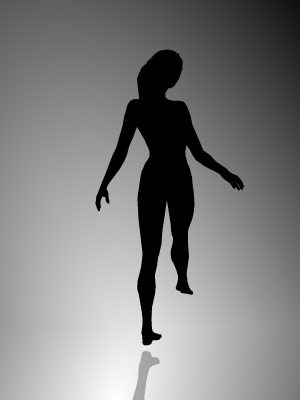
M. C. Escher
Maurits Cornelis Escher , usually referred to as M. C. Escher , was a Dutch graphic artist. He is known for his often mathematically inspired woodcuts, lithographs, and mezzotints...
, Bridget Riley
Bridget Riley
Bridget Louise Riley CH CBE is an English painter who is one of the foremost proponents of Op art.-Early life:...
, Salvador Dalí
Salvador Dalí
Salvador Domènec Felip Jacint Dalí i Domènech, Marquis de Púbol , commonly known as Salvador Dalí , was a prominent Spanish Catalan surrealist painter born in Figueres,Spain....
, Giuseppe Arcimboldo
Giuseppe Arcimboldo
Giuseppe Arcimboldo was an Italian painter best known for creating imaginative portrait heads made entirely of such objects as fruits, vegetables, flowers, fish, and books – that is, he painted representations of these objects on the canvas arranged in such a way that the whole collection of...
, Marcel Duchamp
Marcel Duchamp
Marcel Duchamp was a French artist whose work is most often associated with the Dadaist and Surrealist movements. Considered by some to be one of the most important artists of the 20th century, Duchamp's output influenced the development of post-World War I Western art...
, Oscar Reutersvärd
Oscar Reutersvärd
Oscar Reutersvärd , "the father of the impossible figure", was an artist who pioneered the art of impossible objects. These are images such as what was later renamed the Penrose triangle that appear to depict solid objects, which, however, are impossible to construct in reality...
, Victor Vasarely
Victor Vasarely
Victor Vasarely was a Hungarian French artist whose work is generally seen aligned with Op-art.His work entitled Zebra, created by Vasarely in the 1930s, is considered by some to be one of the earliest examples of Op-art...
and Charles Allan Gilbert
Charles Allan Gilbert
Charles Allan Gilbert , better known as C. Allan Gilbert, was a prominent American illustrator. He is especially remembered for a widely published drawing titled All Is Vanity...
. Contemporary artists who have experimented with illusions include Octavio Ocampo
Octavio Ocampo
Octavio Ocampo was born on 28 February 1943 in Celaya, Guanajuato, Mexico. He grew up in a family of designers, and studied art from early childhood. At art school, Ocampo constructed papier mache figures for floats, altars, and ornaments that were used during carnival parades and other festivals....
, Dick Termes
Dick Termes
Dick Termes is an innovative American artist who uses a six point perspective system that he devised to create unique paintings on large spheres called Termespheres.-Termespheres:...
, Shigeo Fukuda
Shigeo Fukuda
was a sculptor, graphic artist and poster designer who created optical illusions. His art pieces usually portray deception, such as Lunch With a Helmet On, a sculpture created entirely from forks, knives, and spoons, that casts a detailed shadow of a motorcycle....
, Patrick Hughes
Patrick Hughes (artist)
Patrick Hughes is a British artist working in London. He is the creator of "reverspective", an optical illusion on a 3-dimensional surface where the parts of the picture which seem farthest away are actually physically the nearest....
, István Orosz
István Orosz
István Orosz Hungarian painter, printmaker, graphic designer and animated film director, is known for his mathematically inspired works, impossible objects, optical illusions, double-meaning images and anamorphoses. The geometric art of István Orosz, with forced perspectives and optical...
, Rob Gonsalves
Rob Gonsalves
Rob Gonsalves is a Canadian painter of magic realism with a unique perspective and style. He produces original works, limited edition prints and illustrations for his own books....
, Gianni A. Sarcone
Gianni A. Sarcone
Gianni A. Sarcone and Marie-Jo Waeber are writers and authors of columns and articles for newspapers and magazines featuring visual puzzles and math brain teasers. They are contributing editors to 'Focus Giochi' and 'Rivista Magia'...
, Ben Heine
Ben Heine
Ben Heine is a Belgian multidisciplinary artist. Starting as a painter and political cartoonist, he became more widely known in 2011 for his "Pencil vs Camera" and "Digital Circlism" projects...
and Akiyoshi Kitaoka
Akiyoshi Kitaoka
is a Professor of Psychology at the College of Letters, Ritsumeikan University, Kyoto, Japan.Kitaoka was born in Kochi, Japan. In 1984, he received a BSc from the Department of Biology, University of Tsukuba, Tsukuba, Japan, where he studied animal psychology and neuronal activity of the...
. Optical illusion is also used in film by the technique of forced perspective
Forced perspective
Forced perspective is a technique that employs optical illusion to make an object appear farther away, closer, larger or smaller than it actually is. It is used primarily in photography, filmmaking and architecture...
.
Cognitive processes hypothesis
The hypothesis claims that visual illusions occur because the neural circuitry in our visual system evolves, by neural learning, to a system that makes very efficient interpretations of usual 3D scenes based in the emergence of simplified models in our brain that speed up the interpretation process but give rise to optical illusions in unusual situations. In this sense, the cognitive processes hypothesis can be considered a framework for an understanding of optical illusions as the signature of the empirical statistical way vision has evolved to solve the inverse problem.Research indicates that 3D vision capabilities emerge and are learned jointly with the planning of movements. After a long process of learning, an internal representation of the world emerges that is well adjusted to the perceived data coming from closer objects. The representation of distant objects near the horizon is less "adequate". In fact, it is not only the Moon that seems larger when we perceive it near the horizon. In a photo of a distant scene, all distant objects are perceived as smaller than when we observe them directly using our vision.
The retinal image is the main source driving vision but what we see is a "virtual" 3D representation of the scene in front of us. We don't see a physical image of the world; we see objects, and the physical world is not itself separated into objects. We see it according to the way our brain organizes it. The names, colours, usual shapes and other information about the things we see pop up instantaneously from our neural circuitry and influence the representation of the scene. We "see" the most relevant information about the elements of the best 3D image that our neural networks can produce. The illusions arise when the "judgments" implied in the unconscious analysis of the scene are in conflict with reasoned considerations about it.
See also
External links
- Optical illusions and perception paradoxes by Archimedes Lab
- Project LITE Atlas of Visual Phenomena
- Akiyoshi's illusion pages Professor Akiyoshi KITAOKA's anomalous motion illusions
- Spiral Or Not? by Enrique Zeleny, Wolfram Demonstrations ProjectWolfram Demonstrations ProjectThe Wolfram Demonstrations Project is hosted by Wolfram Research, whose stated goal is to bring computational exploration to the widest possible audience. It consists of an organized, open-source collection of small interactive programs called Demonstrations, which are meant to visually and...
- Hunch Optical Illusions by Hunch
- Silencing awareness of visual change by motion by Harvard vision lab
- Upload an image to convert it to an AfterImage. Disclaimer:Viewing such images repeatedly may not be a healthy habit for the eyes by Murtaza Gandhi

